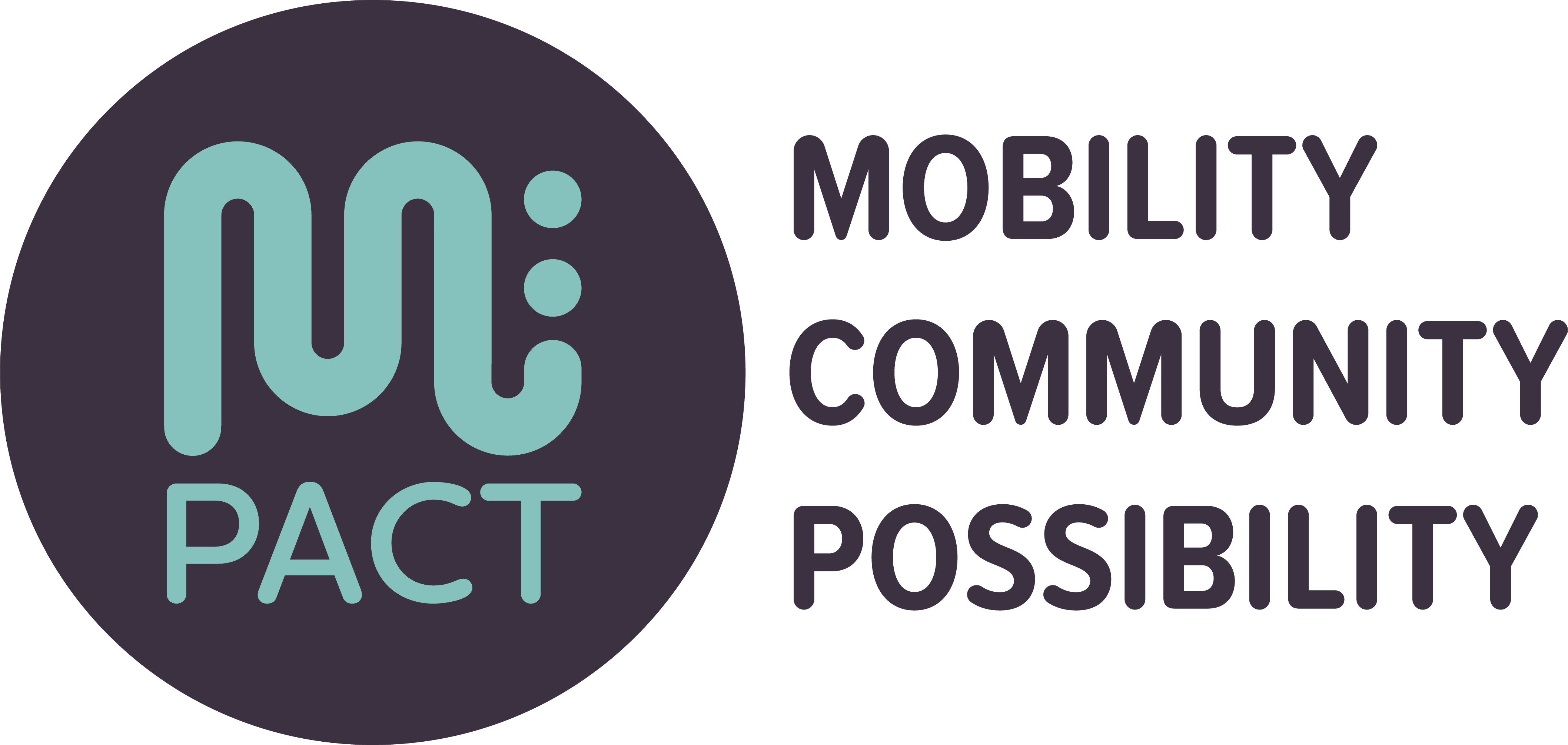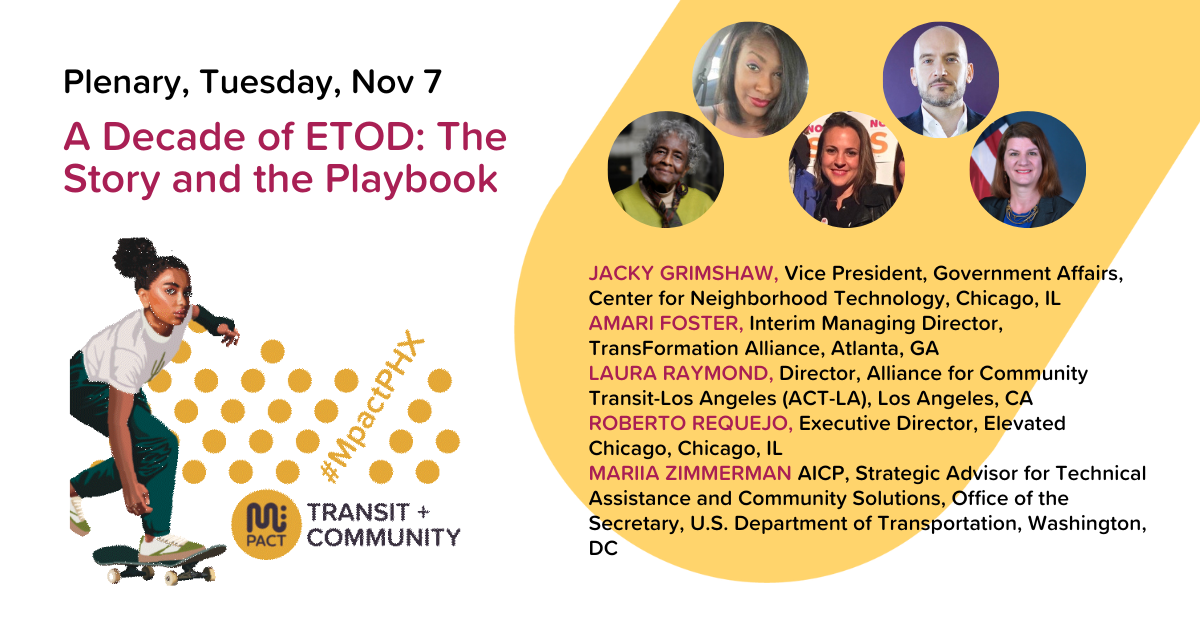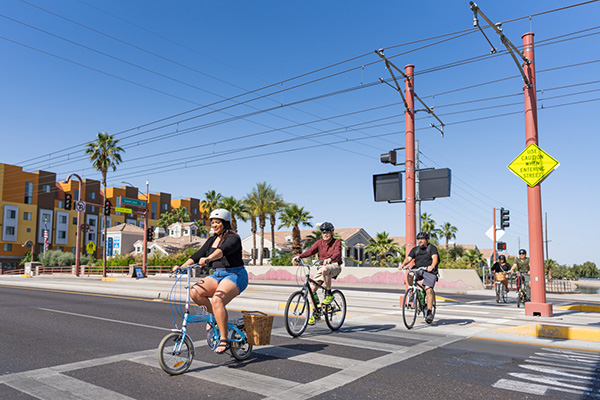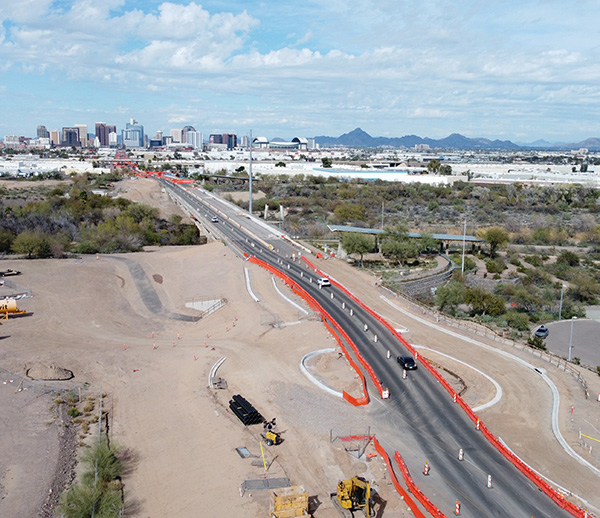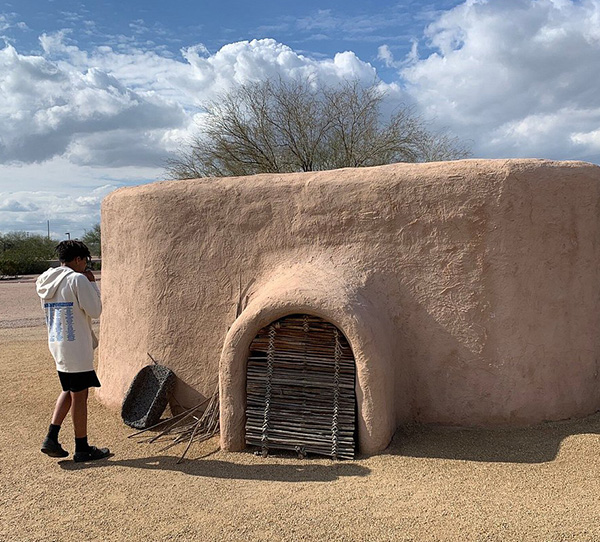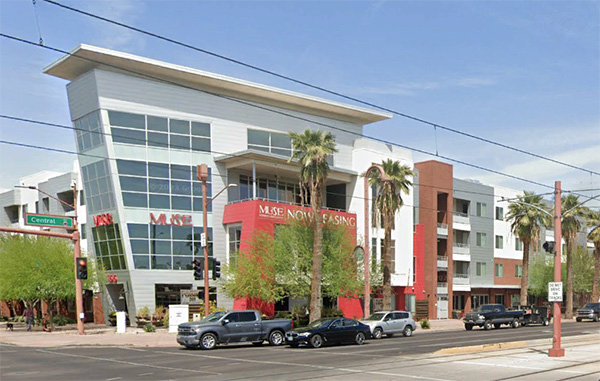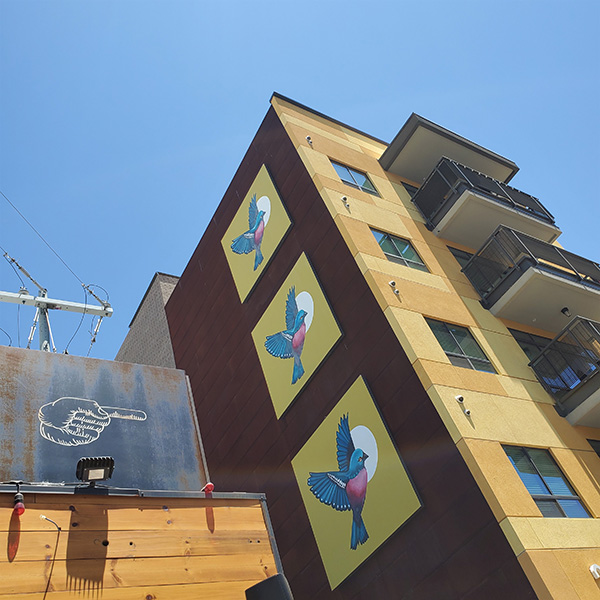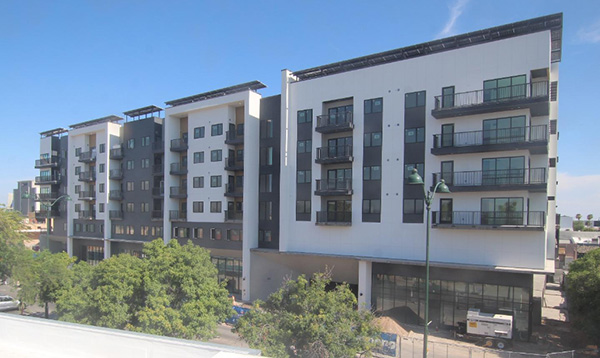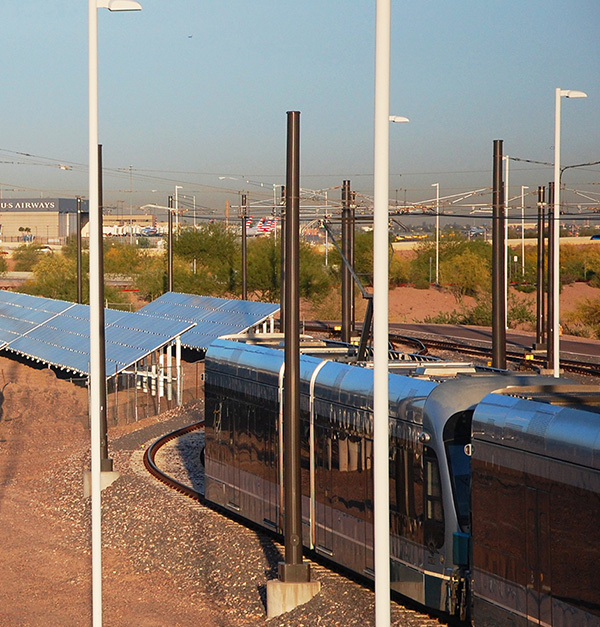Networking
Mpact Innovators Presents – Fast Charge: Breath Work and Chair Yoga
Valley Overlook, 4th Level
Dive into a tranquil pause that promises relaxation, mental clarity and a refreshing break from the daily grind. This morning break is thoughtfully divided into two parts:
- Mindful Breathing. Explore two evidence-based breathing techniques designed to relieve stress and heighten alertness in just 5 minutes.
- Chair Yoga. Navigate an accessible series tailored to counteract the physical strains of prolonged desk work.
Suitable for beginners and skilled practitioners looking for more tools for their wellness toolbox. Wear comfortable attire for the best experience.
Facilitator: Shantelle Dreamer, 200-hour Yoga Teacher Training/ Lead Sustainable Transportation Planner, WSP USA, Boulder, CO
Plenaries
Tuesday Plenary – A Decade of ETOD: The Story and the Playbook
Phoenix Ballroom, 3rd Level
Welcome – Earl Blumenauer, Congressman, 3rd District, Oregon
Plenary – A Decade of ETOD: The Story and the Playbook
During the past decade, the “ETOD” movement has moved from aspiration to practice. The work of embedding Equity into traditional Transit-Oriented Development now has a storybook of milestones reached and projects launched. And it has a playbook of players and plays drawn from successful work in a range of cities. Come learn from top national leaders about their journeys and the practical tools, policies and strategies they’ve used to put equity at the center of development around transit hubs, often in car-centric, inequitable cities. Each city requires a custom approach to address local dynamics and realize the potential of ETOD. But there also are ingredients all cities need for success. Hear about them from leaders who bring experience in collaboratives focused on transit justice and affordable housing, with partners including community-based organizations, philanthropy, federal agencies, financial institutions and developers. They will share what they wish they had known a decade ago, what they know now, and what their hopes and plans are for the future. Lively and informative – with opportunities for audience input – this discussion will ring the bell on what we hope will be a new era for ETOD. Decision-makers and advocates will come away with insights into how ETOD can ease the increasing costs of transportation and housing (especially for low- and fixed-income residents and essential workers) and address the deep climate, public health, and equity crises affecting cities across North America.
Jacky Grimshaw, Vice President, Government Affairs, Center for Neighborhood Technology, Chicago, IL
Amari Foster, Interim Managing Director, TransFormation Alliance, Atlanta, GA
Laura Raymond, Director, Alliance for Community Transit-Los Angeles (ACT-LA), Los Angeles, CA
Roberto Requejo, Executive Director, Elevated Chicago, Chicago, IL
Moderator: Mariia Zimmerman, AICP, Strategic Advisor for Technical Assistance and Community Solutions, Office of the Secretary, U.S. Department of Transportation, Washington, DC
Mobile Workshop
MW14 Grand Canal Multi-Use Trail
$65
You’ve heard of rail to trail, how about canal path to trail? The Phoenix metro area has 180 miles of canals, more than Venice and Amsterdam combined. Learn how the Grand Canalscape project converted the under-used utility corridor along one segment of canal into an attractive, vibrant and well-utilized community asset – one of the longest multi-use urban trail corridors in the state. Dig into the design details of the numerous at-grade bike/ped crossings where the canal intersects major arterials. As you ride the LRT and bike along the path, get an overview of the history and maintenance of the canals as well as of the multiple-use agreements with the Salt River Project, which manages the canals. You’ll take home fresh ideas about the under-used utility corridors waiting for transformation in your community!
Bicycling, Walking, Trail-Oriented Development, Street Design.
Mobile Workshop
MW15 The Asian District: Along the Light Rail in Mesa
$65
The Asian District in Mesa, Arizona, is the southwest’s most vibrant center for Asian culture, community and commerce. More than 70 Asian-themed restaurants, groceries and other service and retail businesses are clustered along Dobson Road and on Main Street, adjacent to light rail: Mekong Plaza, International Marketplace and H Mart. Hear from city leaders and business owners about the evolution of the district, including community engagement around creating a brand to promote the area, business development, sales tax growth and a public-private partnership to bring visually striking murals to the corridor. Get a first-hand sense of the many different cultures visible in the district. Ready for some boba?
Check out the Mesa Asian District Brochure from the City of Mesa, AZ
Session
How Transit is Responding to Security Challenges
Encanto A, 2nd Level
Employees, riders, policymakers and the business community all want the same thing: A safe transit experience for all. So, what’s the best route to take? Can we reimagine transit security with the strategic use of technology – to improve outcomes and better monitor transit spaces for riders and employees? What are some of the innovative ways to increase presence in the system? And what can we do to ensure our frontline workers are protected from anti-social behaviors? Join us, share your concerns and learn from transit leaders who are implementing on-the-ground strategies to improve security for riders and workers.
Moderator: Flora Castillo, President, Mpact, Board of Directors, Ventnor, NJ
Adrian Ruiz, Director, Safety and Security, Valley Metro, Phoenix, AZ
Ken Divers, Director, Outreach Programs, Southeastern Pennsylvania Transportation Authority (SEPTA), Philadelphia, PA
Andrew Wilson, Chief Safety Officer, TriMet, Portland, OR
Session
TOD Practitioners’ Forum
Ahwatukee, 2nd Level
Are you a transit-oriented development (TOD) manager at a transit agency? Or a city or county staffer tasked with making TOD happen? Maybe you work for a redevelopment authority or other financing entity? Whatever the case, get together with folks like you, who make TOD dreams a reality. Don’t expect many presentations, if any. Instead, dive into discussion. Your voice will be heard – what you care about, what you’re struggling with and where you’ve found the creative solution to a problem your peers are likely to face. This is a peer exchange, pure and simple. Come to ask and discuss, or just listen and learn.
Facilitator: Breen Masciotra, AICP, EcoDistricts AP, Senior Project Manager, evolve environment::architecture, Pittsburgh, PA
Session
Transit Agencies and MPOs: Stepping Up to Lead TODs
Laveen, 2nd Level
How can agencies that lack land use authority nonetheless try to shape local jurisdictions’ planning and zoning regulations? How can regional players collaborate to set goals for density near transit, affordable housing, parking management and multimodal station access? Learn how to develop or advocate for a consistent transit-oriented development (TOD) or transit-oriented communities (TOC) policy on a regional level and how to lean on state laws to help pass the policy. Hear from stakeholders involved about the key issues and questions they have struggled with along the way and the lessons learned. Come away with a clearer understanding of how to create a region-wide policy that is specific enough to advance meaningful change yet flexible enough to accommodate the diversity of land use and transportation contexts throughout the region. It’s all about creating communities that work better for people.
Moderator: Craig Sklenar, Global Lead, Transit-Oriented Communities/Urban Designer, Stantec Consulting, Montreal, QC
Ian Carlton, Senior Economic Advisor, ECONorthwest / Co-Founder, MapCraft.io, Portland, OR
Kara Vuicich, AICP, Principal Planner, Metropolitan Transportation Commission (MTC), San Francisco, CA
Maribeth Feke, AICP, Director of Programming and Planning, Greater Cleveland Regional Transit Authority, Cleveland, OH
Matthew Moss, Manager, Strategic Initiatives, City of Cleveland, Ohio, Cleveland, OH
Julie White, Deputy Secretary for Multi-Modal Transportation, North Carolina Department of Transportation, Raleigh, NC
Trail-Oriented Development, Station Design, Parking, Policy.
Session
Pivoting to Plan B in Austin
Cave Creek, 3rd Level
After years of unsuccessful votes, the people of Austin, Texas, finally passed a transit funding measure in November 2020. Following the vote, the Austin Transit Partnership (ATP) advanced work on two light rail corridors. But as design progressed, the cost of the program grew to a size that wasn’t feasible. Hear how a variety of players, including the regional transit partnership, transit agency, city, and community-led advisory groups, developed a new implementation plan within funding constraints and in sync with community values and equity goals. This is the story of stops, starts, ups, downs, and the pivot to Plan B. Built on breakthroughs in community engagement and a renewed vision of what transit means for the region, it might even be better than Plan A.
Moderator: Jennifer Pyne, AICP, Executive Vice President, Planning, Community and Federal Programs, Austin Transit Partnership, Austin, TX
Jose (Chito) Vela, City Council Member, District 4, City of Austin, Texas, Austin, TX
Veronica Casto de Berrera, Board Chair, Austin Transit Partnership, Austin, TX
Awais Azhar, Chair, Project Connect Community Advisory Committee, Austin Transit Partnership, Austin, TX
Session
Streetcar: Living the Dream
Maryvale A, 2nd Level
Whether it’s a legacy streetcar system like Philadelphia’s, or the newer systems in Tucson and Seattle, the streetcar has made a revival. Serving as a driver for both economic development and accessibility, these systems are turning heads for their role in revitalizing communities. But how do they measure success? And where are they headed in the future? Hear from experts as they cover both heritage systems making a comeback and modern versions that are blurring the lines between nostalgia and next-generation thinking.
Moderator: Kay Shelton, AICP, Vice President of Capital Planning, Dallas Area Rapid Transit (DART), Dallas, TX
Logan Axelson, Deputy Program Director, Trolley Modernization, Southeastern Pennsylvania Transportation Authority (SEPTA), Philadelphia, PA
Rhett Crowninshield, Transit Administrator, Tucson Department of Transportation, Tucson, AZ
Jonathan Dong, Transit Strategic Advisor, Seattle Department of Transportation, Seattle, WA
Brian Kellogg, PE, PTP, PTOE, Transportation Engineer, Planner, DKS Associates, Seattle, WA
Session
Microgrids: More Than Powering Buses
Encanto B, 2nd Level
Transit systems across the world share the ambition to be more sustainable and resilient. In response, electrification has become a buzzword. Yet electrification by itself isn’t necessarily more sustainable and resilient than power from fossil fuels. Micorgrids to fuel buses can make a huge difference. Harnessing renewable energies such as solar, wind or hydro, microgrids reduce GHG emissions, provide an independent power source for transit agencies, allow communities to participate in utilizing the energy and, in many instances, reduce lifecycle costs for the operator. Unless you’re already an expert, come for an introduction to microgrids – how they work, the opportunities they present and the challenges they face.
Moderator: Georg Josi, PhD, P.Eng, Partner, DIALOG, Edmonton, AB
Chrissy Mancini Nichols, National Director of Curb Management and New Mobility, Walker Consultants, San Francisco, CA
Tim Victor, eMobility Project Lead, Scale Microgrids, Los Angeles, CA
Session
Humanizing Highways: Wait … What?
Maryvale B, 2nd Level
State routes often are the conduit to major economic centers and other destinations that transit riders need. Yet, they also often present significant barriers to safe, appealing, accessible transit, let-alone transit-oriented development. State and federal DOT design standards deserve much of the blame, but transit agency policies and local government codes also can reinforce the car-centric nature of these routes. So, how do we adapt? Join an idea exchange about how to overcome barriers — political, interpersonal and physical — to transit on state routes, and why it matters. Find out about efforts to shift state DOTs from auto-focused road-builders toward a more expanded definition of mobility. Hear about efforts to collaborate across agencies, to listen and make changes to planning, design and implementation. Yes, it is possible to make state routes better for transit and for people walking and bicycling.
Moderator: Darby Watson, AICP, ASLA, Senior Vice President, Parametrix, Seattle, WA
Philip Harris, AICP, Transit Integration Planner – Management of Mobility Division, Department of Transportation, State of Washington, Seattle, WA
Alex Krieg, Director, Access, Integration and Station Area Planning, Sound Transit, Seattle, WA
Amy Cummings, AICP, Statewide Transportation Planning Manager, Parametrix, Las Vegas, NV
Fred Young, Active Transportation Specialist, Parametrix, Seattle, WA
Mobile Workshop
MW16 Bringing LRT to South Phoenix: Design, Construction, Community
$65 (includes lunch)
Valley Metro’s 5-mile light rail extension to South Central Phoenix is the largest system expansion since the construction of the original 20-mile light rail line. The project includes 11 new stations with artwork by 18 local artists. The design involves conversion of an arterial street to a pedestrian plaza, two roundabouts with LRT, five traction power substations and a new park and ride. Slated to open in 2024, the extension survived a challenge in 2019, when Phoenix voters rejected Proposition 105 and the “4 Lane No Train” campaign, both of which sought to halt the project. Learn about the various phases of construction and experience first hand the South Phoenix community as it evolves through construction.
Networking
Mpact Innovators Presents: Walking Tour – Rail Extensions & the Downtown Hub
Get on your feet and embark on a captivating walking tour of downtown Phoenix. First we’ll explore the current construction and progress of the 5.5-mile South Central light rail extension, which aims to enhance accessibility and connectivity for residents and visitors to south Phoenix. Then we’ll head to the 1.4-mile Capital light rail extension to the west, intended to link downtown Phoenix with a neighborhood filled with historic landmarks. We’ll end at Cityscape, a vibrant downtown hub where you’ll find over a dozen restaurant options to grab lunch.
Networking
Mpact Innovators Presents: Walking Tour – Arizona Center and Heritage Square
Explore pockets of downtown Phoenix that offer a sense of both history and revitalization. The Arizona Center, across from the hotel, is one of the first mixed-use projects in downtown, featuring dining, shops, refreshing green space and waterways as well as new high-rise developments. See how the desert landscape interacts with the built environment. Continue to the ASU Mercado, where Spanish-style buildings provide space for classrooms, local businesses and offices. And then on to Heritage Square and Science Park, with buildings from the 1800s now occupied by museums and restaurants.
Facilitator: Johnathan Gates, City Management Fellow, City Manager’s Office, City of Phoenix, Arizona, Phoenix, AZ
Mobile Workshop
MW18 Tracks through Time: Uncovering Hohokam Culture
$45
Light rail construction in Phoenix has added to our knowledge of the Hohokam people, the region’s very first canal builders. Conveniently enough, you can hop on the light rail to visit the museum where the evidence uncovered during construction – from pottery, tools and jewelry to pit houses, kilns, roasting pits and canals – are collected, catalogued and stored or displayed. Learn about the federally-prescribed processes involved in discovery of archaeological evidence. The work requires close coordination with Native American tribes, particularly when human remains are found. Also develop an understanding of the implications for construction schedules. Hear these stories as you travel to S’edav Aki (formerly Pueblo Grande Museum), an archaeological site once inhabited by the Hohokam culture. You’ll come away with an appreciation of the way that light rail infrastructure is part of the continuing story of human civilization. We are literally uncovering and increasing knowledge of the past as we lay the tracks for the future.
Mobile Workshop
MW17 Tour de Core! Infill along Light Rail in Downtown Phoenix
$65
Fifteen years ago light rail opened in the Valley, connecting Phoenix to Tempe and Mesa. Extensions of light rail and streetcar in Tempe have followed or are in process. Over this time, $2.3 billion in capital investment has led to $17.1 billion in public and private investments within a half mile of station platforms. What are the specifics? Let several light rail stops in the Phoenix downtown core tell the story. Hear how the city adopted neighborhood TOD policies and rezoned to a Walkable Urban Code, with the goal of supporting infill and investment along the system. Progress from stop to stop, gathering insights from new and veteran business owners and developers about what high capacity transit can bring to the local economy and community, including specifics about mall adaptive reuse projects and mixed use projects that foster spaces for family-owned businesses. Come away with a sense of the magnitude of infill, a taste of what transit means to the local community and a great restaurant list for the rest of your time in Phoenix.
Session
Parking from All Angles
Encanto A, 2nd Level
A developer, a transit agency and a lawyer walk into a room. No, this isn’t a joke. It’s a deep dive on parking – from all angles! Convertible parking. Legalizing no parking. Eliminating parking requirements. The future of parking in TODs – is there any?! Come hear about the history and trends in parking reform and policies at state and local levels, with context from across the country and from specific developments – including a multifamily project with no parking at all!
Moderator: Kenny Starr, AICP, Manager, Joint Real Estate Development, Southeastern Pennsylvania Transportation Authority (SEPTA), Philadelphia, PA
Terry Shook, FAIA, Founding Partner, Shook Kelley, Inc., Charlotte, NC
Catie Gould, Senior Transportation Researcher, Sightline Institute, Portland, OR
Ian Fitzpatrick, Managing Principal, Transit Oriented and Institutional Development, LLC, Silver Spring, MD
Patrick Siegman, Principal, Siegman & Associates, San Francisco, CA
Session
Station Design and Wayfinding: Enhancing the Customer Experience
Maryvale A, 2nd Level
As humans, when we have good experiences, we come back. We’re happier. We feel seen and cared for. So let’s discuss the customer experience and how station design — ease of access, wayfinding, ADA and design features — can attract riders to transit, and keep them comign back. Specifically, we’ll highlight how major cities across America are prioritizing their customers and making worthwhile investments in both legacy and non-legacy systems.
Moderator: Anna Crider, Partner, Entro Communications, Inc., New York, New York
Julie Montgomery, Director of Architecture and Art, Sound Transit, Seattle, WA
Adam Light, Senior Director, Los Angeles County Metropolitan Transportation Authority (METRO), Los Angeles, CA
Seth Garland, Director, Washington Metropolitan Area Transit Authority (WMATA), Washington, DC
Session
Capping Projects Through Time: Lessons Learned
Maryvale B, 2nd Level
New highway capping projects seek to reconnect communities that were severed by transportation infrastructure projects. But success requires more than reconnecting streets. It requires a holistic view of neighborhood transformation and planning for connectivity at different scales. Find out about the many different types of projects that reconnect communities and how projects are getting done. Learn how equity, a core component of the Reconnecting Communities Pilot Program, is supported by focusing on enhanced mobility, access, health and economic development. Recognize that technical challenges are often easier to overcome than meeting the goal of restoring social connections, strengthening community institutions and improving health outcomes. Gain perspective about the resources and expertise these projects need to win both funding and support.
Moderator: Jack Robbins, Partner, Director of Urban Design, FXCollaborative, Brooklyn, NY
Jenifer Ross- Amato, Senior Vice President, WSP-USA, Denver, CO
Rosa Fleming, Director of Tourism, Conventions and Events, City of Dallas, Dallas, TX
Annie Lockyer, Finance Manager, City of Dallas, Dallas, TX
Economic Development, Health, Community Engagement, Equity, Federal Funding, Planning.
Session
Cross-sector Partnerships for Affordable Housing
Cave Creek, 3rd Level
While there is a lot of policy focus on creating affordable housing at transit-rich locations, actually doing it can require aligning transit agency plans – for a particular TOD or for a particular station-area – with the priorities of very different organizations, each with their own purposes and resources. For example: how about a transit agency partnering with a school district to build a middle school and affordable and workforce housing all on the same parcel – and all in walking distance to transit? Or a transit agency with a developable parcel working upfront with public and private funding partners to unlock even more affordable housing than originally scoped? What does it take at the senior leadership level and for those carrying out day-to-day work to align policy and workflows? To learn and build trust? Get the stories from projects in two different cities.
Eileen Higgins, Commissioner, District 5, Miami-Dade County, Miami, FL
Mara D’Angelo, Deputy Director, Transit-Oriented Development, Sound Transit, Seattle, WA
Moderator: Mariia Zimmerman, AICP, Strategic Advisor for Technical Assistance and Community Solutions, Office of the Secretary, US Department of Transportation, Washington, DC
Project Management, Trail-Oriented Development, Affordable Housing, Workforce Development.
Session
#OptOutside: Transit and Recreational Access
Laveen, 2nd Level
Currently 100 million Americans (including 28 million children) do not live within a 10-minute walk of a park. So how are transit agencies working with other partners to help bridge the gap in recreational access? Come hear multiple stories, learn best practices and discuss some of the operational challenges to providing access to the outdoors – in major metropolitan areas and rural communities.
Moderator: Corrie Parrish, Senior Planner, Kittelson & Associates, Inc, Portland, OR
Kate Elliott, Principal, Nelson\Nygaard Consulting Associates, Inc., New York, NY
Amy Schlappi, Executive Director, Columbia Area Transit, Hood River, OR
Andrea Breault, Transportation Director, Cascades East Transit, Bend, OR
Britt Card, Planner, Pasadena Transit, Los Angeles, CA
Session
Economic and Workforce Development: Equity and Cultural Competence
Encanto B, 2nd Level
Transportation projects increasingly are moving beyond traditional economic development goals, defined by job access, to embrace the value that these projects bring for workforce development and small or disadvantaged business growth at the local level. Hear from agencies that have developed innovative policies and initiatives for cultural competency, workforce development, job creation, apprenticeships and advanced DBE (Disadvantaged Business Enterprise) and local hiring goals. These exemplary programs strive to bring additional benefit to local communities and economies where transit projects are built. Hear, too, from organizations advocating for national policy changes to streamline and improve disadvantaged business participation on transportation projects.
Moderator: Monica Villalobos, PhD, AICP, Principal, Vicus Planning, Los Angeles, CA
Brad Owen, Senior Executive Officer, Program Management, Los Angeles County Metropolitan Transportation Authority (METRO), Los Angeles, CA
Patti Olds, President and Chief Executive Officer, Kuniklo Corporation, Phoenix, AZ
Kelie Thomas, Light Rail Coordinator, City of Phoenix, Arizona, Phoenix, AZ
Samantha Slusher, Director, Equity in Infrastructure Project, Washington, DC
Economic Development, Workforce Development, Businesses, Community, Policy.
Session
The Never Ending Importance of a Story Told Well
Phoenix Ballroom C, 3rd Level
We all are tapped to tell the story of transit’s role in our communities, in a multitude of settings. Whether it’s to engage the community in a new project or service, inform stakeholders about the benefits of our work or convince elected officials of the value to their constituents, we all have a story to tell. But do we really understand how it’s being received? Do we know how to make it resonate for the most impact? Do we understand the need for our story to evolve, even as we tell it time and again? And, if needed, do we know how to get our story back on track? Come hear from a few amazing storytellers, with lessons and tips for reinforcing the power of a story well told.
Moderator: Kim Pallari, Vice President, Strategic Communications, HDR, Sacramento, CA
Tara Jones, Communications Manager, AECOM, Atlanta, GA
Mary Jo Pitzl, Reporter, The Arizona Republic, Phoenix, AZ
Jerome Gray, Executive Vice President & Chief Communications Officer, Metropolitan Transit Authority of Harris County (METRO), Houston, TX
Session
Investment in People: Rail Supportive Community Development
Ahwatukee, 2nd Level
Let’s look together at cities that are making strides in expanding transit without causing displacement to existing residents and businesses. How? With context-specific approaches, time-tested anti-displacement strategies and by investing in stabilizing local people and places as part of the planning stages of rail expansion. Investment in people is harder than investment in development. We’ll learn what’s working – and not – as these locations try to capture the momentum of new transit investment for the benefit of historically disinvested communities or those struggling with affordability.
Moderator: Anthony Taylor, Development and Engagement Strategist, BIKIFY Consulting, Minneapolis, MN
Elbert Whitfield, Senior Planner, Solomon Cordwell Buenz International, Chicago, IL
Courtney Chavez, Senior Vice President Equity and Community Partnerships, Austin Transit Partnership, Austin, TX
Sarah McMinimy, Transportation Planner, Steer, Los Angeles, CA
Mobile Workshop
MW19 Arts Pave the Way: Roosevelt Row
$45
Roosevelt Row, downtown Phoenix’s walkable arts district, is an urban creative space that nurtures arts-focused initiatives for artists and entrepreneurs. Over the past decade and more, it has grown from a small collection of galleries hosting a “First Fridays” event to a major cultural and economic force in Phoenix. The arts district started as a grassroots movement, with artists who could afford the rent in a rundown area. The story of how it became one of the most visited and eclectic arts and cultural areas in the Valley is fascinating. Get the full story, including the involvement of arts and community members, the City of Phoenix, Valley Metro and Arizona Public Service, the state’s largest electricity provider.
Mobile Workshop
MW20 Main Street Mesa: New Development, Historic Character
$65
Downtown Mesa, the heart of the third largest city in Arizona, is driving new development while working to maintain its historic character and support a diverse mix of local businesses. Explore downtown Mesa’s Main Street area, including transit-oriented development along the light rail. Focal points include: environmentally sustainable housing; business development programs – including a restaurant incubator – focused on equitable success for local entrepreneurs; and educational facilities designed to drive cultural exchange through media. And that’s not all. Learn about downtown’s growing retail and restaurant scene, including breweries and ciderhouses. Find out what tools the City of Mesa is using to drive this development.
Mobile Workshop
MW21 Inside the Operation and Maintenance Center
$45
Go behind the scenes to the facility where light rail and streetcar vehicles are serviced and maintained. Valley Metro recently expanded its Operations and Maintenance Center (OMC) to accommodate more vehicles for a growing system. The new facility will support 90 vehicles (up from 50) and 66 miles of line. The update also included installation of solar panels to power the work, three new storage tracks, a new cleaning platform system and expansion of the buildings for Maintenance of Way and Maintenance of Equipment. You’ll come away with an appreciation for the OMC as the very heart of the light rail and streetcar system and all it does to connect the Valley.
Session
Microtransit: Transit Savior or Political Stopgap?
Maryvale A, 2nd Level
While micro-transit is a new tool for some transit agencies, many have been using it for decades. Learn about the role of microtransit in the agency’s suite of services – and what makes it work well or fail. How does microtransit work as a first-last mile connector to fixed-route transit? What are trade-offs of implementing micro-transit versus fixed-route transit, in terms of cost, convenience and capacity? How does micro-transit fit into the service equity and Title VI conversation? Get answers to these questions and your own, with examples and context from cities and suburbs.
Moderator: Aaron Xaevier, Planner III, Valley Metro, Phoenix, AZ
Charlie Stanfield, AICP, Planning Project Manager, Regional Transportation District (RTD), Denver, CO
China Thomas, Director, Transit Capital Projects, Gwinnett County, Georgia, Lawrenceville, GA
Jing Xu, Assistant Vice President, Service Planning and Scheduling, Dallas Area Rapid Transit (DART), Dallas, TZ
Session
Pushing the Joint Development Envelope: Jurisdictional Partnerships
Phoenix Ballroom C, 3rd Level
Joint development is transit-oriented development (TOD) that occurs on transit agency land or through some other transaction to which the agency is a partner. Within the larger TOD arena, joint development is important for three reasons. It captures land value for transit; it requires integrated planning among the transit agency, the developer and the land use jurisdiction; and it sets the standard for other TOD in the affected station area or corridor. But what if the transit agency doesn’t own developable land? Or lacks the legal authority to pursue joint development? Or runs street-running service that doesn’t intersect with the surrounding real estate fabric? Find out about innovative strategies from different transit systems that “push the envelope,” expanding the concept and reach of joint development through partnerships with other jurisdictions. While the fine-grained details of each example may be unique to its jurisdiction, each represents a broadly replicable strategy.
Moderator: Al Raine, PhD, Vice President and National Practice Leader, AECOM, Boston, MA
Shannon Price, Executive Director of Integrated Development, British Columbia Ministry of Transportation and Infrastructure, Vancouver, BC
Jack Wierzenski, AICP, Director, Economic Development, Dallas Area Rapid Transit (DART), Dallas, TX
Sherri Ziller, President and Chief Executive Officer, Northwest Indiana Regional Development Authority, Crown Point, IN
Session
Mpact Innovators Presents: Idea Exchange – AI for Planners
Ahwatukee, 2nd Level
Embark on a thoughtful, hands-on exploration of AI in transit and urban planning. In a rapidly evolving digital age, artificial intelligence (AI) is not only transforming our virtual realms. It’s also influencing our urban environments. Dive into methods for fostering a more fruitful and balanced relationship with AI. Break into groups to interact with AI tools and craft a conceptual transit campaign. Learn about AI’s capabilities in forecasting urban expansion, designing safer transit routes and streamlining traffic dynamics. We’re not coming together to laud technology blindly. We want to share and critique strategies and guidelines for balanced AI adoption, learn ways to harmonize human-AI interactions and envision a future where AI aids us in crafting a more sustainable, secure and inclusive global community.
Kenny Starr, AICP, Manager, Joint Real Estate Development, Southeastern Pennsylvania Transportation Authority (SEPTA), Philadelphia, PA
Shantelle Dreamer, Sustainable Transportation Planner, WSP USA, Boulder, CO
Ana Zanza, Urban Design Planner, HNTB Corporation, Chicago, IL
Design, Technology, Planning, Data.
Session
Bus Network Redesign: A Changing Landscape
Laveen, 2nd Level
Many cities and agencies across the country are now or have recently embarked on bus network redesigns to address changes in the transit landscape, among them new travel patterns post-pandemic, demographic shifts, funding constraints and operator or workforce shortages. While there is no “one-size-fits-all” solution, there are plenty of lessons learned, innovative approaches and new tools to share. Let’s hear from three locations, each at different stages. How are they approaching their bus network redesign? What data and key performance indicators (KPI) are they using? How are they engaging with their local communities? And what funding outlook does each have to consider?
Moderator: Arturo Herrera Jr., Special Projects Manager, VIA Metropolitan Transit Authority, San Antonio, TX
Dalia Leven, AICP, National Planning Lead for Transit and Shared Mobility, Cambridge Systematics, Inc., Washington, DC
Kate Lyman, AICP, Manager, Service Planning and Development, TriMet, Portland, OR
Sandip Sen, GISP, Director, Service Planning & Scheduling, VIA Metropolitan Transit Authority, San Antonio, TX
Session
Equitable Decision-Making: From Ambition to Action
Encanto A, 2nd Level
Many organizations have diversity, equity and inclusion (DE&I) policies in place. But what moves a program from analysis and engagement to action and outcomes? Take a look at three programs making decisions centered on equity: Miami-Dade County’s New Mobility Project, Sound Transit’s Everett Link Extension Equitable TOD project and the Washington/Oregon I-5 Interstate Bridge Replacement program. One program employed community members to strengthen engagement. Another combined research, outreach and model codes for local agencies to facilitate equitable development outcomes. The last defined a long-term plan for equity in facility planning, contracting and investment. Together, we’ll dive into lessons learned, opportunities, hurdles and methods for measuring success.
Moderator: Elisa Young, Director of Diversity, Equity and Inclusion, Parametrix, Seattle, WA
Jen Cheek, Director of Healthy Streets and Public Spaces, Urban Health Partnerships, Miami, FL
Miranda Ridinger, AICP, High Capacity Transit Development Manager, Department of Planning, Environment and Project Development, Sound Transit, Seattle, WA
Johnell Bell, Chief Executive Officer, Espousal Strategies, Portland, OR
Jarice Rodriguez, Transportation Research Manager, Miami-Dade County, Miami, FL
Community Engagement, Equity, Planning, Transit, Data, Policy.
Session
Community Engagement 201: The Practical Application of Capacity Building
Encanto B, 2nd Level
How do you achieve community engagement in which community members have the information and tools they need and deserve, to not only effectively participate in public processes but also make decisions about the facilities and infrastructure they will use or be affected by? It’s daunting. Explore case studies and programs that seek to change the trajectories for historically-marginalized communities’ experience with transit and redevelopment projects. Find out about collaborations between transit riders, workers and local residents. Hear about creative strategies for building the capacity and political power of community members to shape policy and push for environmental justice.
Moderator: Ryan Boyd, President, Urban Phoenix Project Network, Phoenix, AZ
Benito Perez, AICP CTP CAPP, Policy Director, Transportation for America, Washington, DC
Masavi Perea, Coalitions and Training Director, CHISPA AZ, Phoenix, AZ
Cheryl Stephens, Community Organizer, Pittsburghers for Public Transit, Pittsburgh, PA
Economic Development, Community Engagement, Equity, Capacity Building, Transit Riders.
Session
Getting to Transit: Expanding Last-mile Access
Maryvale B, 2nd Level
Active modes of mobility are key to reaching transit, especially in auto-dominated environments. This is particularly true in under-served communities, as came into sharper focus during the pandemic. Explore the current status and need for safe, multi-modal connections to rapid transit — with national research and metrics, including origin and destination surveys, safety audits and lessons learned. Get the story from different cities about what it takes to deliver safe, comfortable and equitable access to transit, from planning, approvals and engagement, to funding, design, implementation and maintenance.
Omar Peters, AICP, Senior Planner, Toole Design Group, Denver, CO
Neil Quarles, Engineer, Transportation Department, City of Austin, Texas, Austin, TX
Travis Liska, Principal Transportation Planner, North Central Texas Council of Governments (NCTCOG), Arlington, TX
Funding, Design, Community Engagement, Planning, Transit, Data.
Networking
Mpact Innovators Presents: The Mpact PK Slam
Orpheum Theater, 203 W Adams St, Phoenix
Creative, candid, energetic! The PK Slam features stand-up presentations in the style of PechaKucha™. This year’s venue: a Spanish-revival style theater in downtown Phoenix originally used for vaudeville acts. Don’t miss this Tuesday night tradition – the one everybody talks about!
Americo Gonzalez Aquino, Transportation Design Principal, HDR, Inc., Astoria, NY
Brittany Hoffman, Public Information Officer, Valley Metro, Phoenix, Arizona
Therese Lang, Principal/CEO, Lang Public Relations and Communications Consulting, Portland, Or
Breen Masciotra, AICP, EcoDistricts AP, Senior Project Manager, evolve environment::architecture, Pittsburgh, PA
Heidi Sokolowsky, Principal, Urban Field Studio, San Francisco, California
Christof Spieler, PE, AICP, LEED AP, Director of Planning, Huitt-Zollars, Houston, TX
Madeleine Pelzel, Planner, Huitt-Zollars, Houston, TX
Shantelle Dreamer, Lead Sustainable Transportation Planner, WSP USA, Boulder, CO
Renata Tirta, Active Transportation Programs Manager, Portland Bureau of Transportation, City of Portland, Portland, OR
Peter Ohlms, Senior Research Scientist, Virginia Transportation Research Council (VDOT), Charlottesville, VA

